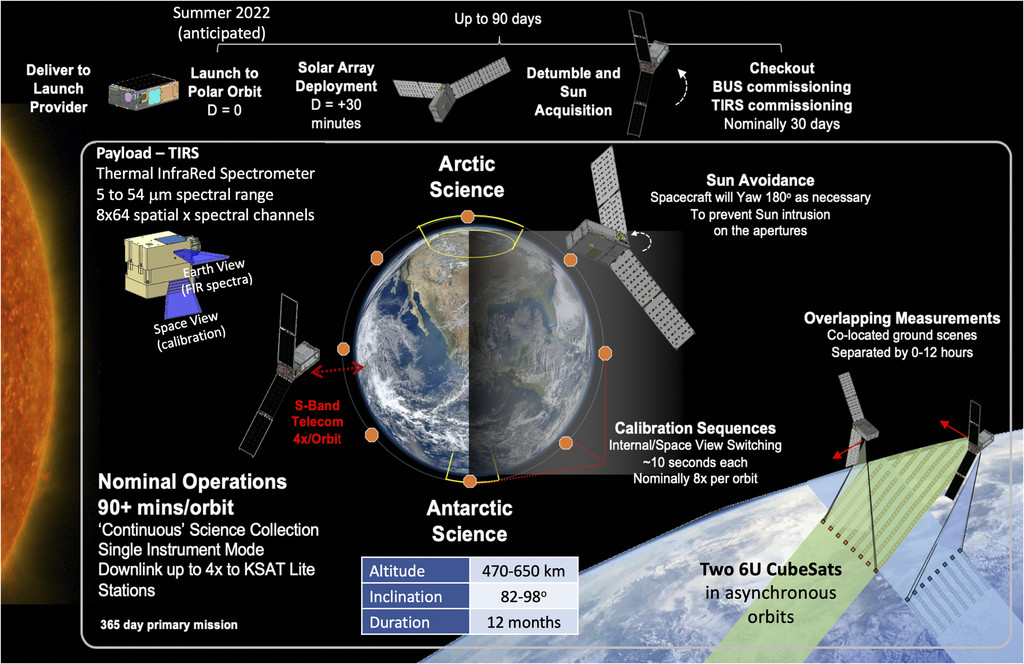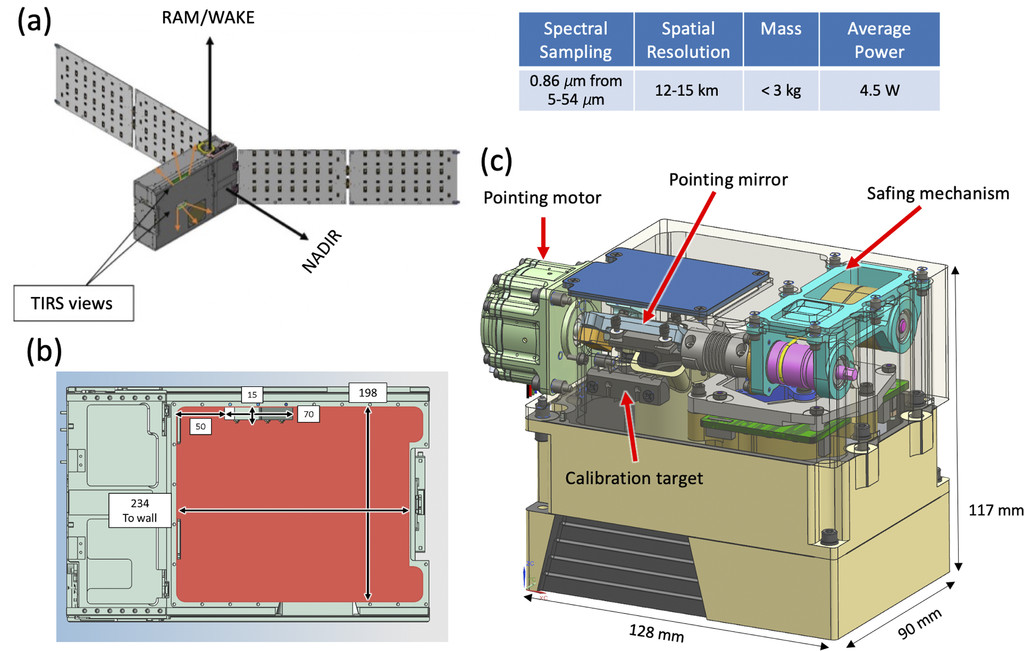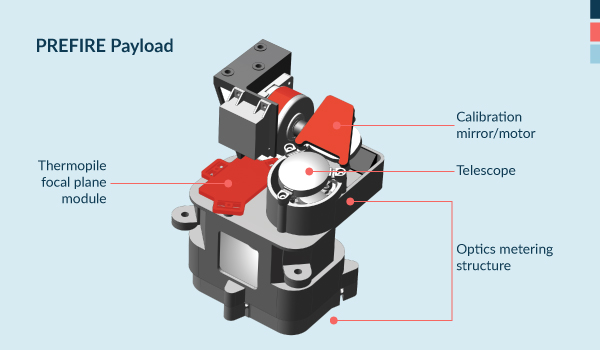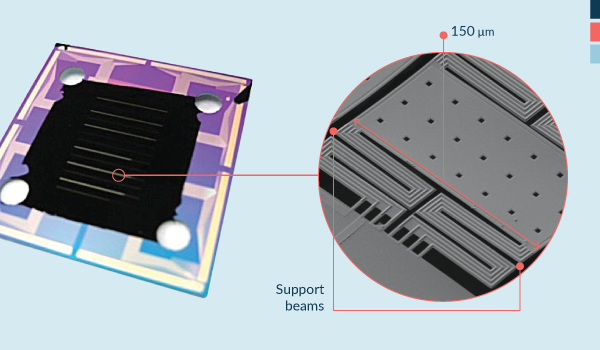PREFIRE (Polar Radiant Energy in the Far-InfraRed Experiment)
EO
Atmosphere
Radiation budget
NASA
The Polar Radiant Energy in the Far Infrared Experiment (PREFIRE) will fly a pair of 6U CubeSat satellites to probe a little-studied portion of energy emitted by Earth for clues about Arctic warming, sea ice loss, and ice-sheet melting. The mission is a collaboration between the National Aeronautics and Space Administration Jet Propulsion Laboratory (NASA/JPL) and the University of Wisconsin-Madison Space Science Engineering Centre (UW SSEC) and the first satellite was launched in May 2024.
Quick facts
Overview
| Mission type | EO |
| Agency | NASA |
| Mission status | Operational (nominal) |
| Launch date | 25 May 2024 |
| Measurement domain | Atmosphere |
| Measurement category | Radiation budget |
| Measurement detailed | Upward long-wave irradiance at TOA |
| Instruments | TIRS (PREFIRE) |
| Instrument type | Hyperspectral imagers |
| CEOS EO Handbook | See PREFIRE (Polar Radiant Energy in the Far-InfraRed Experiment) summary |
Overview
The Polar Radiant Energy in the Far Infrared Experiment (PREFIRE) will fly a pair of small CubeSat satellites to probe a little-studied portion of energy emitted by Earth for clues about Arctic warming, sea ice loss, and ice-sheet melting. PREFIRE will fly miniaturised thermal infrared spectrometers on two 6U CubeSat platforms. The sensors are based on technology previously flown on the Mars Climate sounder. PREFIRE satellites will orbit Earth’s poles to measure far-infrared emissions and how they change throughout the day and over the seasons.
The observations will allow scientists to assess how changes in the thermal infrared emission at the top of Earth’s atmosphere are related to changes in cloud cover and surface conditions below, such as the amount of sea ice and meltwater on the surface of the ice.
PREFIRE measures variations in Far-Infrared (FIR) emissivity and the greenhouse effect via thermal radiometric sampling at the top of the polar atmosphere. These measurements are integrated with models to understand the role of FIR radiation in the Arctic climate. The Arctic is the Earth’s thermostat and it regulates the climate by venting excess energy received within the tropics. Therefore, it is important to study the Arctic thermal radiation. Nearly 60% of Arctic emission occurs at wavelengths greater than 15 μm that have never been systematically measured. PREFIRE fills this gap in measurements and improves climate prediction by anchoring spectral far-infrared emission and atmospheric greenhouse effects.

Spacecraft
The baseline mission consists of two 6U CubeSat spacecraft in two different 470-650 km altitude, near-polar (82°-98° inclination) orbits, each with a heritage miniaturised IR spectrometer, covering the 0-54 µm region at 0.84 µm spectral resolution, operating for one seasonal cycle (a year) with diurnal subsampling.
The threshold mission would consist of one 6U CubeSat spacecraft (470-650 km altitude) in near-polar orbit (82° - 98° inclination), operating for a half seasonal cycle (6 months).
Launch
The first PREFIRE satellite was launched on May 25, 2024, on board Rocket Lab’s Electron rocket from Launch Complex 1 in Māhia, New Zealand, at 7:41 a.m. UTC.
The second PREFIRE satellite was launched on June 5, 2024 from Rocket Lab's New Zealand site at 03:15 a.m. UTC, on an Electron rocket.
Orbit: The two 6U cubesats will be in distinct 470-650 km, near-polar orbits with an orbital inclination of 82°-98°.
Mission Status
June 5, 2024: Rocket Lab launched the second of two CubeSats for NASA's PREFIRE climate change mission onboard an Electron rocket, which lifted off from Rocket Lab's commercial launch site in New Zealand at 03:15 a.m. UTC.
The satellite was initially planned to launch on May 31, but was postponed due to an "out-of-family sensor reading." 8)May 25, 2024: The first of a pair of NASA’s climate satellites was launched from Launch Complex 1 in Māhia, New Zealand at 7:41 a.m. UTC, on Rocket Lab’s Electron rocket. Communications with the CubeSat was successfully established at 12:48 a.m. UTC. 7)

Figure 2: Rocket Lab’s Electron rocket lifted off from Launch Complex 1 at Māhia, New Zealand at 7:41 a.m. UTC carrying a small satellite for NASA’s PREFIRE (Polar Radiant Energy in the Far-InfraRed Experiment) mission. (Image credit: Rocket Lab).
- Early 2018: PREFIRE was one of two selections made in the fourth NASA Earth Venture Instrument (EVI-4) opportunity which will, for the first time, measure the variability in spectral fluxes from 5-45 microns on hourly to seasonal timescales and will reveal fluctuations in Earth’s thermostat by capturing the full spectrum of Arctic radiant energy. The other selected mission, EMIT, to be hosted on the ISS, will map the surface mineralogy of arid dust source regions via imaging spectroscopy in the visible and short-wave infrared (VSWIR). The mission is cost-capped with a budget of $US 32.78 M.
- Early 2018: The University of Wisconsin (UW) Department of Atmospheric and Oceanic Sciences and Space Science and Engineering Centre (SSEC) collaborates with NASA to take the lead on the PREFIRE mission with Tristan L’Ecuyer as the Principal Investigator.
- 16 June 2020: The official PREFIRE mission website, hosted by UW SSEC, was launched.
- January 2023: The PREFIRE satellites are due to be launched in August 2023.
Sensor Complement
TIRS (Thermal IR Spectrometer)
Each PREFIRE CubeSat will carry its own Thermal InfraRed Spectrometer (TIRS), a pushbroom spectrometer with 64 channels that measure mid and far-infrared radiation from 5 to 54 µm at 0.86 µm resolution. The dimensions and a rough schematic of the TIRS are shown in Figure 2. TIRS continuously records eight cross-track pixels with a ground spacing of approximately 7 km. In order to meet the mass, power and cost constraints imposed by a CubeSat platform, an uncooled focal plane is required. TIRS is thermally isolated from the spacecraft and regulated through controlled dissipation of its steady-state power. It is calibrated by rotating a calibration mirror to provide space and internal calibration views, eight or more times per orbit. The intentional calibration includes a radiometric measure of all light using the zeroth-order reflection off the grating. TIRS will provide measurements of spectral fluxes, column-water vapour, surface emissivity and broadband radiances over the majority of thermal wavelengths.


The expected radiometric performance of TIRS is better than 1.5 K (at 300K) for all individual MIR and FIR channels from 5 to 54 µm.
Performing the required accurate and sensitive radiometric measurements across infrared and far-infrared wavelengths in a miniaturised satellite is achieved with the help of JPL MDL’s Focal Plane Module (FPM). The FPM will use a thermophile detector array designed and fabricated at MDL with a pixel and format size customised for PREFIRE. The array operates uncooled, which is critical to fitting it in a small CubeSat. The thermopile chip has “gold black” deposited on the pixels to make the pixels sensitive to infrared and far-infrared light. The FPM will utilise custom readout integrated circuits built by Black Forest Engineering that show no measurable low frequency noise enabling the entire FPM to observe the Earth over long integration times to enhance the signal-to-noise ratio of the instrument. 4)

Thermopile array | 64 x 8 pixels |
Spectral sampling | 0.84 µm from 0-54 µm |
Spatial coverage | 8 cross-track pixels with 1.3º footprints |
Resolution summary | 10 m resolution over a 10-15 km sampling range |
Swath width | Nadir pushbroom scanning, perpendicular to orbit track with maximums swath of 300 km. |
Accuracy summary | Measurement noise less than 0.33 K for a 300 K unit emissivity scene in each channel between 6 and 11 microns. Measurement noise less than 1.1 K for a 300K unit emissivity scene, in each channel between 12 and 24 microns. |
References
1) PREFIRE, https://prefire.ssec.wisc.edu. Accessed 16 January 2023.
2) Kahn, Brian H., et al. “Assessment of Sampling Sufficiency for Low-Cost Satellite Missions: Application to PREFIRE.” Journal of Atmospheric and Oceanic Technology, vol. 37, no. 12, 2020, pp. 2283-2298. https://journals.ametsoc.org/view/journals/atot/37/12/jtech-d-20-0023.1.xml. Accessed 16 01 2023.
3) L'Ecuyer, Tristan S., et al. “The Polar Radiant Energy in the Far Infrared Experiment: A New Perspective on Polar Longwave energy Exchanges.” Bulletin of the American Meteorological Society, vol. 102, no. 7, 2021, pp. E1431-E1449. https://journals.ametsoc.org/view/journals/bams/102/7/BAMS-D-20-0155.1.xml?tab_body=fulltext-display. Accessed 16 01 2023.
4) Kenyon, Matt. “PREFIRE.” Microdevices Laboratory, https://microdevices.jpl.nasa.gov/capabilities/broadband-thermal-detectors/prefire/. Accessed 16 January 2023.
5) “New NASA Space Sensors to Address Key Earth Science Questions.” NASA, 5 February 2018, https://www.nasa.gov/press-release/new-nasa-space-sensors-to-address-key-earth-science-questions. Accessed 16 January 2023.
6) Drouin, Brian, et al. “JPL Science: PREFIRE (Polar Radiant Energy in the Far-InfraRed Experiment).” JPL Science, https://science.jpl.nasa.gov/projects/prefire/. Accessed 16 January 2023.
7) NASA Jet Propulsion Laboratory, “NASA Launches Small Climate Satellite to Study Earth’s Poles”, May 25, 2024, URL: https://www.jpl.nasa.gov/news/nasa-launches-small-climate-satellite-to-study-earths-poles Accessed 08 07 2024.
8) Wall, Mike, “Rocket Lab launches 2nd shoebox-sized climate satellite for NASA (video)”, SPACE.com, June 5, 2024, URL: https://www.space.com/rocket-lab-prefire-and-ice-climate-change-mission-launch Accessed 08 07 2024.